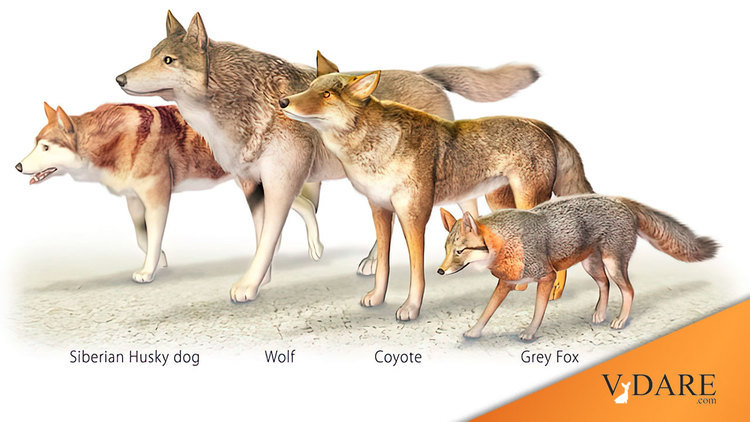
05/22/2011
Race can’t exist because the boundaries are too vague. The existence of species, however, is assumed in the name of the Endangered Species Act. Yet, when we stop and think about dogs, wolves, and coyotes, it’s not immediately obvious whether these familiar beasts should be classified as three species or three races within one species. A press release has some genetic relevant to this old conundrum:
ALBANY, NY.- A State Museum scientist has co-authored a new research article, representing the most detailed genomic study of its kind, which shows that wolves and coyotes in the eastern United States are hybrids between gray wolves, coyotes and domestic dogs.
Dr. Roland Kays, the Museum’s curator of mammals, was one of 15 other national and international scientists who collaborated on the study that used unprecedented genetic technology, developed from the dog genome, to survey the global genetic diversity in dogs, wolves and coyotes. The study used over 48,000 genetic markers, making it the most detailed genomic study of any wild vertebrate species.
The research results are especially relevant to wolves and coyotes in the Northeast. The study shows a gradient of hybridization in wolves, with pure wolves in western states and increasing hybridization as you move east. Wolves in the western Great Lakes area averaged a genetic makeup of 85 percent wolf and 15 percent coyote,
My wife saw one of these wolf-coyote hybrids in Racine, Wisconsin a dozen years ago: it looked big, assertive, and scary like a wolf, but was fairly solitary, like a coyote. In Southern California, in contrast, there are no wolves, and coyotes furtively skulk around by themselves.
while wolves in Algonquin Park in eastern Ontario averaged 58 percent wolf, and the “red wolf' in North Carolina was only 24 percent wolf and 76 percent coyote. Populations of eastern coyotes, which only colonized the region in the last 60 years, were also minor hybrids, with some introgression of genetic material from wolves and domestic dogs. For example, Northeastern coyotes, including those in New York State, had genetic material primarily from coyotes (82 percent), with a minor contribution from dogs (9 percent) and wolves (9 percent). …
Kays said "In most cases this breeding across species lines seems to have happened at times when humans were hunting eastern wolves to extinction, and the few remaining animals could find no proper mates, so took the best option they could get." Kays continues, "The exceptions were an older hybridization between coyotes and wolves in the western Great Lakes dating from 600-900 years ago, and a coyote-dog hybridization in the eastern U.S. about 50 years ago, when coyote were first colonizing eastern forests."
This study also provides fresh data on the controversy over the species status of the Red Wolf in North Carolina, and the Eastern Canadian Wolf in Ontario. Both are medium-sized wolves that some have argued represent unique species. However, this new detailed genetic data shows both are the result of hybridizations between coyotes and wolves over the last few hundred years, and do not share a common origin in a unique eastern wolf species.
This research is also relevant to a recent U.S. Fish and Wildlife proposal to remove the western Great Lakes wolves from the Endangered Species Act by showing that those wolves are only marginally hybridized with coyotes, should be considered a subspecies of the Gray Wolf, and have no genetic ties to a more endangered form of eastern wolf.
As with modern humans and Neanderthals, introgression allows rapid evolution to adapt to new environments:
This study follows another research paper co-authored by Kays last year in the journal Biology Letters, which used museum specimens and genetic samples to show that eastern coyotes hybridized with wolves to rapidly evolve into a larger form over the last 90 years, dramatically expanding their geographic range and becoming the top predator in the Northeast. This hybridization contributed to the evolution of coyotes from mousers of western grasslands to deer hunters of eastern forests. The resulting coy-wolf hybrids are larger, with wider skulls that are better adapted for hunting deer.
Are Neanderthals and modern humans different species? I dunno.
This is a content archive of VDARE.com, which Letitia James forced off of the Internet using lawfare.